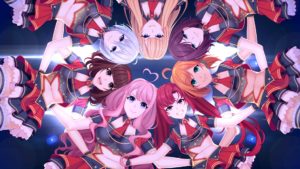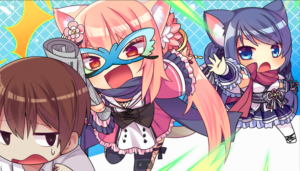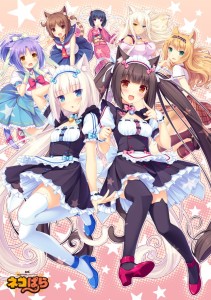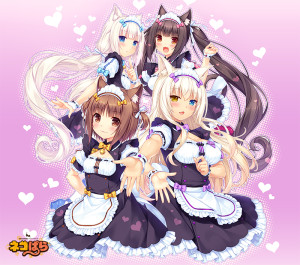I’d like to first state that before this I was never much for idol things of any kind. It was the mysterious passion of a good friend of mine but not much more. Then I happened to come across a Kickstarter for a game from a developer I had heard of but never played, Love In Space. That crowd funding campaign was Shining Song Starnova. As I said, it really wasn’t my bag but the artwork and storyline grabbed me. When I later found out Himari was signed to the project, they had my attention and, more importantly, my support. Cut to a month and a half ago, I had just returned from a long day at work to find a welcome letter in my email with the download code. I figured it was going to be an interesting two weeks. It’s over a month later and I’m still trying to find the words to do this game justice. I have played many before but few are on this thing’s level. That said, I will endeavor to try to shine some starry light on this visual novel that was laid before me that one night not too long ago.
One can’t begin to discuss the characters without first discussing the very excellent talent Love In Space recruited for this project. Chief among them was the voice of the ever effervescent Chocola from Nekopara, Himari. In a manner almost in the vein of Aya Hirano going from Konata Izumi (more on Lucky Star later) to Haruhi Suzumiya, we go from Chocola to the idol onee-san from hell, Mariya Yamamoto. In this role, Himari shines as bright as the star she is playing, the hardened veteran of idol industry and no-matter-the-center team captain whose cynical outlook snaps all of the other girls back to reality. However, I was really impressed by the fact that she alone got her own solo song in the game and…well, it certainly had my spirits singing. However, she is certainly not alone, a number of recognized talents are also among the cast. From Nemu being voiced by the same seiyuu for Anna in Tropical Liquor to Aki’s seiyuu also voicing the role of Ichika Hashima in Momoiro’s Closet, I get to hear some familiar voices from other series I’ve been checking out lately.
This brings us to the characters themselves, which I must say I certainly related to in more ways than one. Each and every one of them had an element of myself to them that made the story more immersive as I could feel their pain from their past experiences and their desires to get beyond them. Furthermore, their respective story plots involving the Producer (Kaoru Nishiyama for those who didn’t catch his name) were very heartfelt from Julie finally finding a man who would never abandon her to Natsuki fulfilling a dream to meet her boy idol heartthrob and gain his affection. Part seinen, part josei, it really matters not who you are but rather what you are as the reader that you take what you will from it. For myself, I found Julie and Mariya’s stories the most enjoyable as I always like to see those who had it rough but never lost their spirit achieve great success in the end. May hit too close from some but not me.
Now, we come to the overall story arc and it is here I have my mixed feelings. While I did get some satisfaction working to get the “real” story arc with Sasami, I really wish I didn’t have to unlock it in a way. True, I got to enjoy the many rollercoaster rides of the other gal’s stories but there was just something disconcerting about it. What is more, each story line had a nasty habit of slowing down during the darkest and most grueling points in the story that almost made me want to put it out of it’s misery. This was especially true of Sasami’s story where Shiro nearly corrupts her. I almost couldn’t bear to watch this angel be despoiled but, being the tough lad I am, I grinned and bore it. However, this tension and despair would be quickly released in a supernova burst of elation and triumph at the end, quite fitting for a story about a group of seven girls being reborn in such a celestial manner. It was this exact storyline, a combination of underdog and redemption tropes, that really endeared me to this game when the going got tough. When I want to escape the mundane in games, that’s the kind of story I look for as the ideal. As if that weren’t enough, the references to a variety of subjects really made me pause to admire the level of craftsmanship in the writing of the game. Shiro insinuating that Sasami is like a certain lovable and naive twin sister in Lucky Star and then immediately quoting one of the funniest lines in the movie Tropic Thunder, that’s a level of cross-cultural, pop-cultural gymnastics I’ve never seen done before but I’m most certainly glad I did. Plus, I’ve never heard of a visual novel make references to the Bible, which seems to make it a thinking person’s kind of visual novel. I also like the political/philosophical themes in this story that, according to interviews about the game, Love In Space has deliberately put in but I think that these conclusions may best be left to the individual reader. That said and if I understand this right, it’s a story of the individual and their thoughts, feelings, and aspirations against the sometimes cold, often narcissistic, and frequently nihilistic collectivist reality of the modern consumer culture. It certainly shows that those virtues of friendship, kindness, decency, optimism, being a part of something greater than yourself, and never losing yourself in the process really do matter. It’s the story of seven talented ladies who each want to find personal satisfaction in the synergy of their idol group Starnova under the guidance of a realistically-minded yet idealistically-motivated producer seeking to give them what he never could get for himself in the same situation. That’s my theory anyway.
Beyond the story, this game really got my appreciation in a number of other ways. The artwork was very well done and the transition between images was almost seamless. I also really liked that almost all of the artwork including the backgrounds is accessible in the bonus section of the menu, something I don’t often get with other visual novels. However, what really got me was the animations for the “love” scenes. For those not so technically astute, this game was rendered using the RenPy engine, an engine I thought incapable of rendering animations. What Love In Space did with it was beyond astounding. In fact, I believe they may have attained a new level when it comes to utilizing this Python-based engine as the animations were almost on the same level of fluidity and motion accuracy as those I see in other games based on more advanced, closed-source engines, which is quite an achievement. The voice tracks were good if a little light on actual dialogue in some areas but being that I like to keep the story moving rapidly, I thought it was alright. However, the same cannot be said of the vocal tracks and the overall soundtrack. Both of these are truly award-winning compositions on level that can be classified as nothing other than cinematic. Enlisting the Seycara Orchestra was the one of the best decision the creators made in the design of this game. That rich, golden to the ear soundtrack evoked the aesthetics of the great films I grew up on. I got the soundtrack as part of my support of the crowdfunding campaign and I have been listening to it non-stop since I got it. In fact, it’s stuck in my head, playing on repeat endlessly. That is not something that happens ordinarily and both the musicians and the developers should be properly commended for creating such a profound soundtrack.
I never thought Shining Song Starnova was going to take this long to complete and normally that leaves me grumbling a little about how much time I’ve spent on it. This time, I don’t feel the same. I honestly have a kind of bittersweet feeling about it being finished. I thoroughly enjoyed playing each girl’s story arc and I came to really feel something for it. I almost feel like Junpei as he stood at Starnova’s last live at the Tokyo Dome. Such a feeling must mean I truly have experienced something exceptionally profound. I highly recommend this game and it’s soundtrack. So if you’re looking for a grand adventure with music and drama, then grab your happi coat and light sticks and prepare yourself to see seven stars be reborn in a brilliant flash of light so bright in turns night into day. THEY ARE STARNOVA!!!









